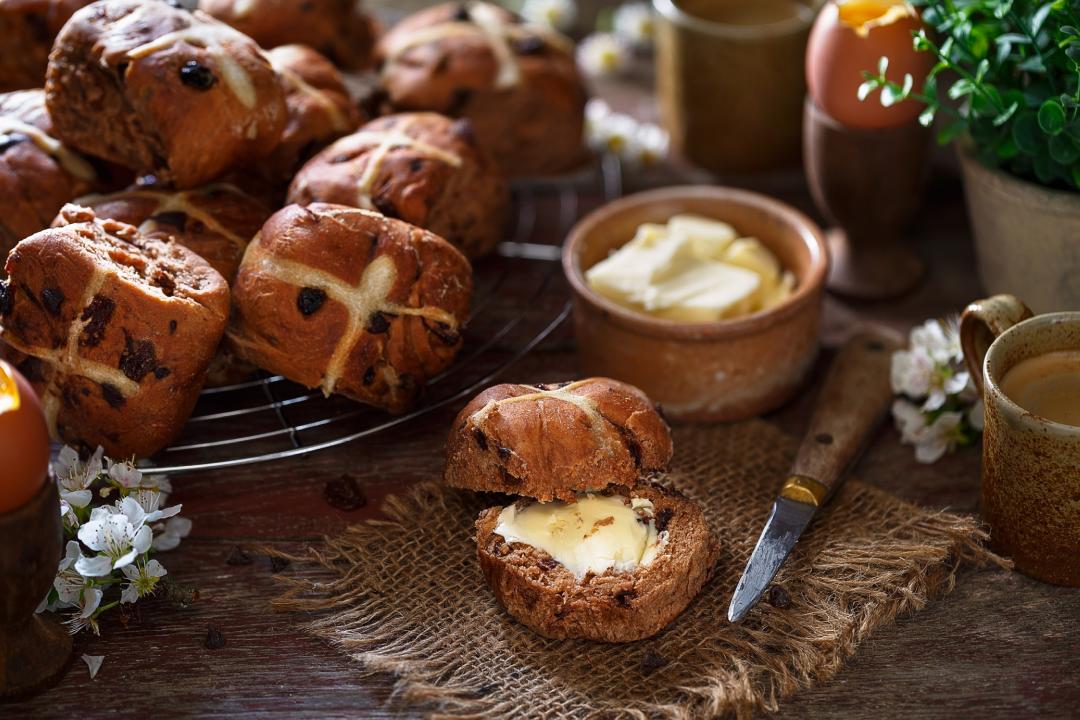A hot cross bun is the wonderful classic comfort of Easter refined into the spicy-sweet aroma of cinnamon, cardamom, nutmeg and cloves, then draped in a sticky glaze. A pot of freshly brewed tea is always its companion.

Ingredients
Fruit
60 g sultanas
60 g currants
60 g raisins
50 g candied fruit peel, finely chopped
Dough
400 g Snowflake bakers’ flour
60 g unsalted butter, softened
60 g brown sugar
20 g fresh yeast or 10 g dried yeast
200 ml milk
1 tsp salt
1 egg
2 tsp ground cinnamon
1 tsp ground nutmeg
½ tsp ground allspice
½ tsp ground cloves
Cross mixture
50 g Snowflake plain flour
50 ml water
1 tbsp sunflower oil
½ tsp orange blossom water (optional)
¼ tsp ground nutmeg
Smooth glaze
150 g castor sugar
150 ml water
1 orange, finely grated zest and juice
Method
- Before you make the dough, you will need to rehydrate the fruit. Put the currants, sultanas and raisins in a heatproof bowl and cover them with boiling water. Allow them to soften in the water for 15 minutes, then drain the fruit, discarding the water. Add the orange peel and mix to distribute it evenly.
- To make your dough, place all the dough ingredients in the bowl of an electric mixer fitted with the dough hook and mix on low speed for 4-5 minutes. You will see that the dough is starting to combine and although it will appear quite sticky, there should now be no flour at the bottom of the bowl. Increase the speed to medium and knead for a further 7 minutes to develop the protein in the dough. At this stage the dough will start to form a ball around the dough hook, peeling away from the sides of the bowl. Add the dried fruit to the bowl and mix for 1 minute longer to evenly distribute the fruit.
- Place the dough in a large, lightly oiled bowl. Cover it with plastic wrap and put it somewhere warm to prove for 1½ hours, or until it has doubled in volume.
- Line a baking sheet with baking paper and set aside.
- Tip the dough out onto a lightly Snowflake floured surface.
- Use a large knife to divide the dough into 12 even portions, then roll each one into a round bun, dusting your hands with a little Snowflake flour to prevent the dough from sticking.
- Arrange the buns on the prepared baking sheet in a neat grid of 12 so that all the horizontal and vertical lines are aligned. Cover the buns with a tea towel and put them in a warm place to prove for 30 minutes or until doubled in volume.
- Preheat the oven to 180° Celsius
- To make your cross mixture, place all the ingredients in a bowl and use a hand whisk to roughly mix them together until they form an elastic batter. A thinner mixture will result in thicker, flatter crosses. So, some prefer a firmer cross mixture, so beat it a bit longer, when piped it will sit on top of the buns. You can adjust the mixture by adding a little water to make it thinner or a little flour to make it thicker – it's entirely up to you. Fill a piping bag fitted with a 7 mm plain nozzle with the crossing mixture, then twist the bag where the mixture stops to ensure the batter doesn't spill out the end.
- Once the buns have doubled in volume, pipe the crossing mixture onto the buns – firstly running in one direction in long continuous lines down the middle of the buns and then, after giving the tray a turn, crossing over those lines in the opposite direction, intersecting the lines exactly in the middle of each bun.
- Place the buns in the oven and bake for 15 minutes, then, without opening the oven door, reduce the temperature to 170° Celsius and bake for a further 15 minutes or until the buns are lovely and golden.
- While the buns are in the oven, start to make the glaze.
- Place all the glaze ingredients in a small saucepan and stir over medium heat until the sugar has dissolved and the mixture begins to boil.
- Simmer for about 5 minutes or until it is thick and syrup, then remove the pan from the heat and set aside.
- If the glaze has become too thick to brush on the buns, briefly return the pan to the heat until it reaches the right consistency.
- Remove the buns from the oven and while they are still hot, brush the tops with the sticky glaze, using a pastry brush so that it drips down the sides of the buns. It is not important for the glaze to be hot when you brush it over the buns, as it will melt nicely as soon as it hits the buns.
- Serve the buns fresh with butter or keep them until Easter breakfast morning. Toast them again and serve with butter, jam and tea.
ENJOY!









